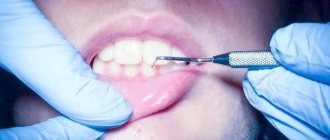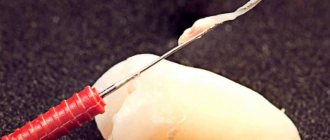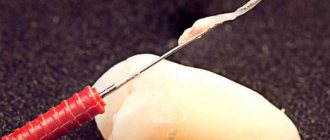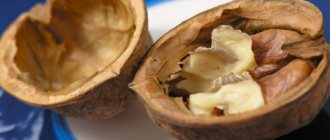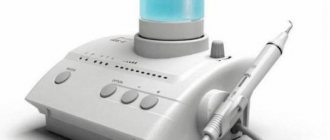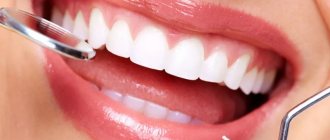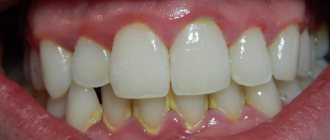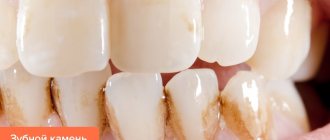Tartar occurs in 85% of people. It is formed due to the influence of 90 types of various microorganisms that penetrate the oral cavity. The resulting plaque remains on the tooth enamel and hardens, which leads to an acceleration of the process of tooth decay. In the article you can learn how to remove tartar quickly and efficiently.
Causes of tartar formation
Tartar formation
Plaque that accumulates on tooth enamel over time turns into a solid mineral deposit, which is difficult to remove without using special actions. 90% of plaque gets on the teeth after eating - it is a thin film in which, in addition to food particles, various microorganisms are present.
The main reasons for the formation of tartar:
- Poor oral hygiene – untimely cleaning, lack of rinsing after meals, tea or coffee.
- Incorrectly performed brushing - if you use a toothbrush that is not suitable for the person or perform incorrect movements while brushing.
- Smoking (nicotine leaves characteristic dark marks on the enamel) – teeth become yellow.
- Excessive consumption of sweets - bacteria remain on the enamel
- Frequent consumption of tea, coffee, red juices.
- Passion for fatty foods.
- Alcoholic drinks - their consumption leaves a coating, which over time hardens and turns into stone.
- Pathologies associated with chewing processes.
- Lack of fresh fruits and vegetables on the menu.
- The predominance of soft food in the diet - food particles remain on the surface of the teeth, since the chewing process is practically not required.
- The use of low-quality toothpastes and rinses in the process of hygiene care.
- Diseases of internal organs.
- Violation of metabolic processes.
- Diseases associated with the gastrointestinal tract.
- Lack of beneficial microflora in the intestines.
- Poor nutrition.
It is also necessary to ensure that the body always has a balance of microelements and vitamins, since the lack of these components increases the growth of tartar.
Symptoms
Symptomatic manifestations of tartar:
- The appearance of dark circles and spots on the enamel.
- A characteristic manifestation is an unpleasant odor from the oral cavity (even after brushing).
- Redness of the gums.
- The appearance of a blue tint on the gums.
- The appearance of blood during brushing or mechanical impact on the gums (for example, while a person eats apples).
- Inflammatory processes in the oral cavity with itching and pain.
At the very beginning of its formation, tartar forms around the neck of the tooth. Visually, it looks like a yellow or brown rim. If no action is taken to eliminate it, the plaque will spread to the crown and then to the periodontal pocket.
Black plaque on a child’s teeth –
As we said above, the mechanism of deposition of insoluble metal salts on teeth will work not only in children, but also in some adults. The fact is that in the oral cavity there are bacteria called actinomycetes. They are anaerobic bacteria and are often called chromogenic bacteria. It is these bacteria that are responsible for the appearance of black or tightly attached plaque, located circularly in the area of the necks of the teeth (Fig. 10-12). Sometimes such plaque may have a brown or greenish tint.
Black plaque in a child -
According to various statistics, the formation of dark plaque occurs in 1 to 20% of all children, and the process itself occurs as follows... Actinomycetes, in the course of their life activity, release hydrogen sulfite, which enters into a chemical reaction with iron compounds contained in saliva. As a result, an insoluble form of iron is formed (with impurities of calcium and phosphorus), which is deposited on the teeth in the form of a black plaque. Moreover, this happens even in patients with high-quality regular oral hygiene.
Scientific studies have shown that the deposition of black plaque in the form of insoluble iron salts is associated with 2 main factors. Firstly, we are talking about the species composition of the microflora of the oral cavity, i.e. The higher the content of actinomycetes in the oral cavity, the higher the risk of black plaque formation. Thus, one of the scientific studies showed that in children aged 6-12 years with black spots, actinomycetes were sown in 70% of cases, and in children without black spots - only in 20% of cases. And this shows an obvious dependence.
In addition to actinomycetes, bacteria of the genus Prevotella, for example, P.gingivalis and P.intermedia, can also lead to the deposition of insoluble iron salts. But they show such activity only if a child or adult has concomitant gum inflammation, manifested by bleeding. Those. These bacteria extract iron from red blood cells that enter the mouth during gum disease, turning it into black plaque. Thus, the presence of gingivitis in the patient is another risk factor.
The connection between black plaque and drinking water –
Scientific studies show that drinking unfiltered tap water, as well as water purified by osmosis, increases the risk of deposition of insoluble iron salts in the form of black plaque by 13 times (you can read the clinical study at this link). How to remove such plaque - read at the very end of the article.
Kinds
Experts distinguish the following types of pathological process:
- Supragingival - the consistency of the stone resembles clay. The expression on the enamel is clear. Removal is easy if you contact your dentist without delaying treatment.
- Subgingival - visually it cannot be recognized at home. You can find out about the problem by incising the gums in the dental office. The formations are dense and hard if you touch it.
- Loose.
- Hardened.
Important! The problem of tartar formation cannot be left without medical (dental) control. If you do not start the removal process on time, inflammation will occur with further formation of caries and damage to the oral mucosa.
It must be remembered that bacteria form under tartar, which constantly release toxins. They then begin to penetrate the blood, with the current of which negative substances spread throughout the body. These substances contribute to the exacerbation of various chronic diseases present in humans.
Dental Care Tips
After eating,
it is recommended to brush your teeth. Cleaning duration is about two minutes.
Use natural ingredients
Do not harm teeth and oral cavity. Buy or use organic toothpastes or dental care products. Modern toothpastes contain components that can damage tooth enamel and worsen oral health.
Dental floss
An easy way to care. It is easy for her to remove pieces of food stuck between her teeth. If you can’t do it during the day, be sure to clean it before bed.
Herbal rinses
Helps maintain a healthy mouth. To care for your mouth, use herbal rinses. A simple and effective method of rinsing with a decoction of thyme and mint. You can rinse with sea water, adding regular water in a ratio of 1 to 3.
Folk advice
They help a lot with their regular use. If you have had tartar on your teeth for a very long time and you can’t get rid of it on your own, it is recommended to consult a dentist for initial cleaning of the tartar. You don’t need to have your teeth cleaned constantly, as this can damage your tooth enamel, but to get your teeth in order for the first time, you can visit a dental clinic, and in the future you can take care of your teeth yourself, not forgetting about regular daily oral health care. Then your teeth will be healthy and tartar can appear on them.
The harmlessness and availability of methods for home use helps many people who note the effectiveness of folk remedies.
If you have your own technique or a proven method, leave your recipes for fighting tartar in the comments.
How to remove tartar in dentistry
Reading techniques in a dental office:
| Process name | Description | Price |
| Mechanical cleaning | It is a traditional form of getting rid of hardened plaque in dentistry. It is performed using a special tool - a drill. Rotation removes deposits from the enamel, and the surface is additionally polished. Feature: you can remove deposits that are superficial. There is discomfort during removal. | On average 200 rubles per 1 tooth. |
| Ultrasonic cleaning | Cleaning using ultrasound can remove up to 90% of deposits. It is used even when stone has formed under the gums. Deposits are eliminated along with bacteria - complete disinfection of the oral cavity is carried out. Discomfort during the procedure may occur in places where the enamel is thinnest or damaged. To reduce pain before the procedure, the teeth are coated with a special dental composition, which will need to be thoroughly washed off at the end of exposure to the tartar. | The average cost of the procedure is 250 rubles per tooth. |
| Laser cleaning | The procedure is considered safe and gentle on enamel. The work is carried out without direct contact with the surface of the tooth or gum. The laser removes deposits layer by layer, transforming them into powder. The next stage is to wash away the remaining deposits with jets of water and air. The patient does not experience any unpleasant or painful sensations. In complex cases, 2-4 procedures are required. Additionally, enamel lightening is achieved, harmful microorganisms are removed, and the condition of the oral cavity is improved. | The average price of the procedure is 850-1100 rubles. |
| Dry cleaning | During the removal process, special compounds based on alkalis and acids are used. Tartar softens, after which the deposit is easily removed by rinsing the mouth. There is no discomfort or pain during the procedure. The compositions in 95% of cases have a pleasant taste. Feature: old deposits cannot be removed. There is a possibility of damage to the enamel or gums and tissues in the oral cavity. | The cost of the procedure is on average 1000 rubles per session. |
Mechanical cleaning Ultrasonic Laser Chemical
Important! Laser cleaning of teeth from deposits has a number of contraindications: age under 18 years, a large number of fillings or increased sensitivity of the enamel.
Grinding and polishing of enamel is also carried out. This procedure is carried out when the deposits on the surface are not old. The technique allows you to remove the smallest particles of stone remaining after the main procedure. The cost averages 250-300 rubles per 1 tooth.
Manual removal of dental plaque
The first tools for removing dental plaque were proposed back in the 7th century. Currently, instruments designed for manual removal of mineralized dental plaque are usually collectively referred to as “scalers.” But despite the age of this invention, manual removal of dental plaque is still in demand.
Advantages:
- Firstly, manual removal of dental plaque has no contraindications.
- Secondly, the cost of such a procedure is affordable for every patient.
- Thirdly, in some areas, tartar can be removed only with the help of these tools.
- Well, the most important advantage is the quality of work. It has been proven that hand instruments after processing form the smoothest root surface, which allows teeth to remain protected from plaque and tartar for longer.
The disadvantages of this method include:
- Labor intensity and time consumption when performing the procedure. In addition, the main criterion for the thoroughness of dental plaque removal is the doctor’s tactile sensation, which does not always help, especially in hard-to-reach places.
- The method is traumatic. Many patients complain of pain not only during the procedure, but also for several days after it. Based on my practice, this method is more suitable for patients of a periodontist, who, after removing dental plaque, prescribes a series of manipulations or procedures.
How to get rid of tartar at home
Be careful not to damage the enamel!
Tartar in the initial stages of its formation can be removed at home. There are a number of traditional methods to clean it:
- Using hydrogen peroxide - you will need to dilute it with water (1:3), apply it to the enamel using a cotton pad. Leave for 2-3 minutes, rinse, repeat the procedure once a week.
- Table salt – soak your toothbrush in water, then dip it in the salt. Brush your teeth for 3 minutes, rinse your mouth well. The cleaning course is 2 weeks daily, after 14 days every other day.
- Baking soda – add water to create a paste-like consistency. The product is applied to the plaque, left for 3-4 minutes, and washed off.
- Natural honey needs to be diluted in warm water. The resulting composition should be rinsed once a week.
- Walnut - walnut bark is used, which needs to be crushed into powder. The resulting component must be diluted with water to the consistency of a decoction. Then rinse once a day for 3-5 minutes.
Decoctions of burdock, celandine, and oak root herbs help get rid of tartar at home, as well as remove possible inflammatory processes and other damage in the oral cavity.
Tartar pastes
To maintain the achieved positive result, for preventive purposes it is necessary to use special toothpastes that contain special particles that can soften and remove deposits. The main ones:
- PRESIDENT White Plus.
- LACALUT White.
It is recommended to use them only after consultation with a specialist.
Special brushes
Brushes for cleaning teeth from tartar should be electric. There are 2 versions of the device:
- With built-in generator (removes deposits in easily accessible areas).
- With a rotating head (effective for removing stone from areas where a regular brush cannot reach).
The devices should also be used after consultation with a specialist.
Royal Denta Silver
Royal Denta Silver toothpaste is very popular among customers, as it provides an excellent therapeutic effect thanks to the silver and gold ions included in the product. Systematic use of toothpaste allows you to quickly restore the natural whiteness of teeth, remove tea and coffee stains, as well as various deposits from the enamel surface. A pleasant bonus from the systematic use of “Royal Denta Silver” is the removal of bad breath.
Preventive measures
Hygienic procedures are required to be carried out 2 times a day. Cleaning is carried out on the inside and outside of the teeth. Additionally, after each meal you need to use dental floss or irrigator. A rinse aid with a disinfectant effect helps reduce the likelihood of deposits forming.
.
Popular questions
- Is it painful to remove tartar? – it all depends on the technique used and the individual characteristics of the body. In 90% of cases there is no pain.
- Does it need to be removed? – the removal process is mandatory, since the stone leads to the destruction of tooth enamel, caries, and inflammatory processes on the gums and tissues.
- Is it possible to remove it with an irrigator? – at the initial stages of sediment formation.
- Which doctor removes tartar? – Periodontist.
- How to remove tartar from a child? – you need to visit a doctor who will perform a procedure to remove soft deposits on the enamel.
- Is it possible to completely remove tartar on your own? – if the problem is at an early stage, only specialists can remove the neglected stone.
- How to soften it and dissolve it before cleaning at home? – use special herbal decoctions, use lemon juice, which is applied to the damaged area with a cotton pad for 2-3 minutes before the main cleaning.
- How to remove it from dentures? – It is necessary to dilute the vinegar with water (1:1), then place the denture in the liquid for 15 minutes, then clean with a regular brush for 2-3 minutes. The procedure is carried out daily.
- How often can you remove tartar? – The frequency of the procedure depends on the chosen technique and the severity of the condition.
- Can I use kerosene? – this method is not recommended, as it can cause harm to health.
The rest of the recommendations will be given by the doctor after an individual consultation.
Removing dental plaque using ultrasound (ultrasonic teeth cleaning)
The ultrasonic method involves removing dental plaque using special scaler tips. The essence of the technique is that the tip, oscillating at high frequencies (from 25 to 50 kHz), loosens and removes tartar. The whole process is accompanied by an abundant supply of water from the tip. Water plays a very important role in removing stones: it protects teeth from overheating, washes away stone fragments, and removes “weak” stones mechanically.
Advantages:
- Fast – With a range of convenient tips available, stone removal is usually very fast. On average, the procedure takes 30-40 minutes.
- Price – in most dental clinics, the price for dental calculus removal is calculated depending on the number of teeth. Often, not all teeth have tartar, which means there is no need to overpay for a segment (half jaw/8 teeth at once), which may not have tartar on them.
- Simultaneous irrigation of the surface with a medicinal product. Modern ultrasonic devices have reservoirs for antiseptic solutions instead of water, which increases the cleansing of the periodontal pocket. The cavitation effect, which occurs when the nozzle vibrates in a solution of water or antiseptic, destroys the membrane of bacterial cells, providing a powerful antimicrobial effect.
- Comfort – as a rule, removal of dental plaque by ultrasound is a painless procedure and does not cause much discomfort to the patient (of course, when used correctly).
But there is also a downside to using ultrasonic teeth cleaning:
- The ultrasonic tip is dangerous in the wrong hands. The fact is that if the techniques are not followed, you can damage not only the gums, but also tooth enamel. In addition, if the doctor uses an old generation handpiece, or does not supply enough water, the tooth may overheat, which can cause inflammation of the dental pulp - pulpitis. However, if used correctly, these problems are not terrible.
- Quite a large number of contraindications. We discuss the presence of certain diseases with each patient.
